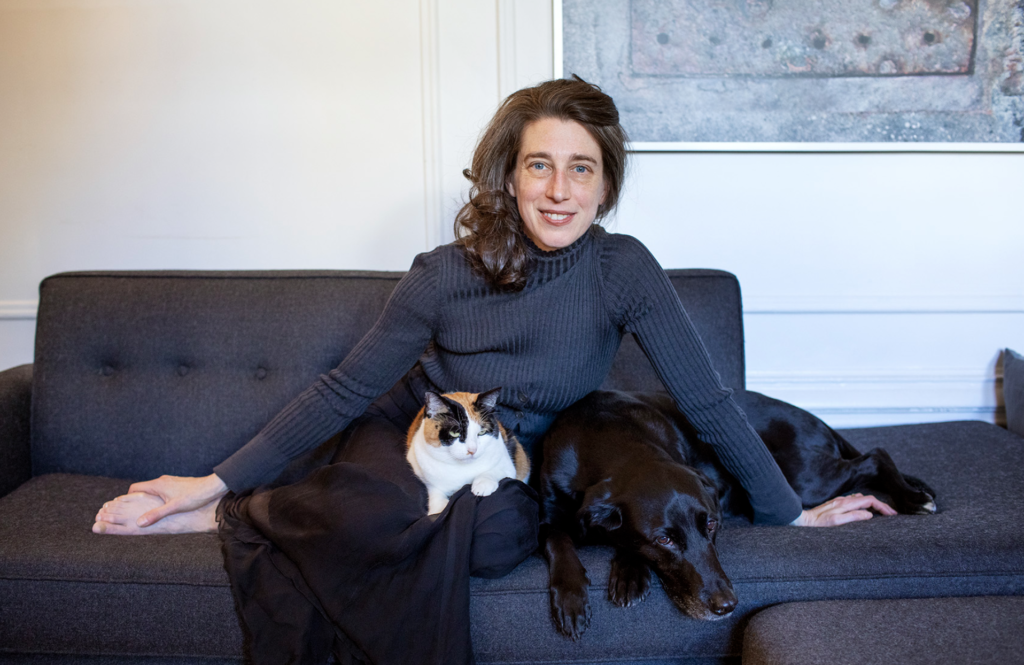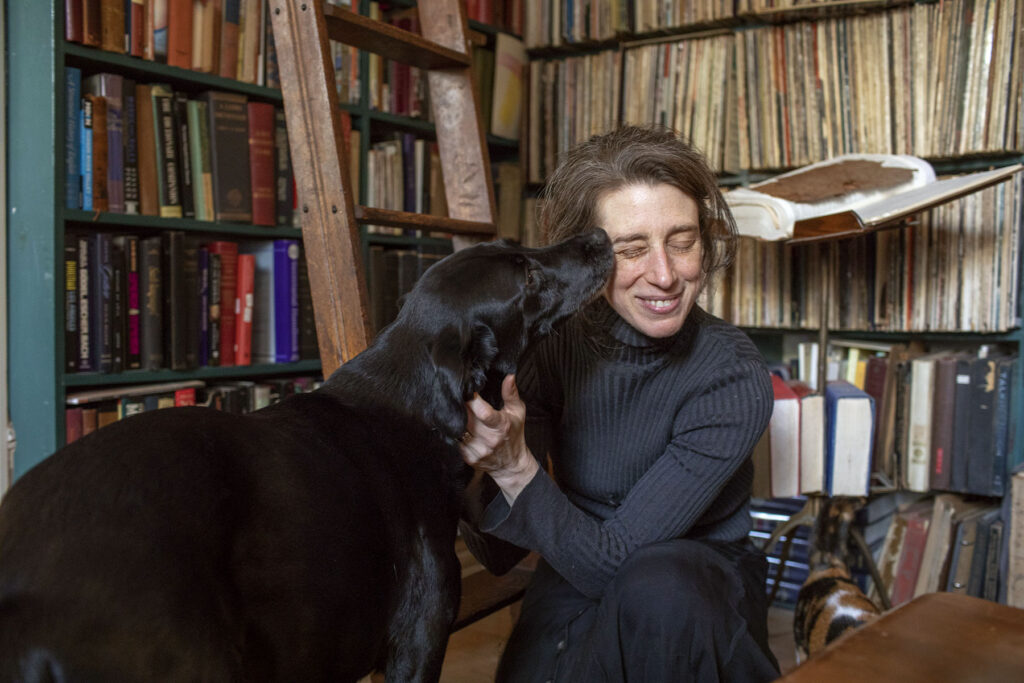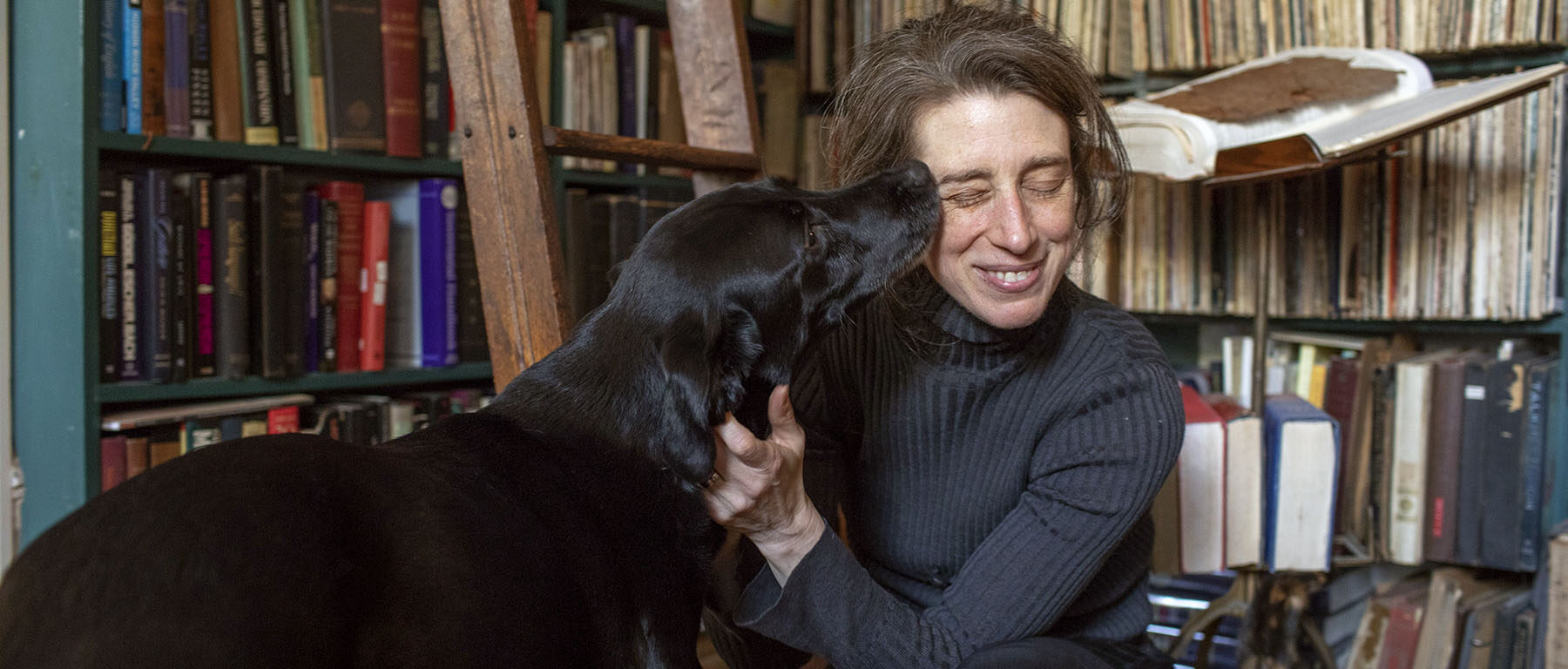O centésimo episódio do Podcast Meu Nome Não É Não não poderia ser mais especial! Queríamos fazer uma edição que representasse a nossa jornada até aqui e tudo o que acreditamos, para isso, convidamos para uma entrevista a pesquisadora que mais admiramos na área de comportamento animal, Alexandra Horowitz.
Ela foi extremamente solícita e gentil conosco, o que só fez aumentar a nossa admiração.
Mas, como Alexandra não fala português, convidamos outra pessoa super especial para nós para representá-la, a educadora canina, Marília Gabriella, do Instagram @cachorropositivo.
Mas fique tranquilo, você também conseguirá ouvir a Alexandra, pois ela nos mandou uma saudação muito carinhosa!
Abaixo, a entrevista escrita original e traduzida que a Alexandra Horowitz concedeu ao Podcast Meu Nome Não É Não.
Episódio Especial n° 100 – Entrevista com Alexandra Horowitz.
Participação especial: Marília Gabriella Araújo Neto (@cachorropositivo) – voz de tradução da Alexandra Horowitz.
Entrevista Original:

MNNEN: On the Dog Cognition Lab’s Instagram profile, we see many posts about studies on many different topics, such as how dogs perceive themselves and other dogs, play behavior… So, how many studies are being conducted at this moment? Please, tell us how many people are involved and what is the primary focus of the research as well.
Alexandra: Thanks for following our work! We do lots of different studies, based on my interests — I am super interested in how dogs perceive themselves and us — as well as the ideas of the researchers. There are usually about 8 researchers working in the lab during the school year, from September through May. In the summer, when most students are away, we usually have a hiatus and simply do data analysis or work on writing up any results we have. This summer, though, we are still running subjects in one of our latest studies, which looks at how dogs perceive themselves and others through their scent. Our current lab manager, Kelly Chan, and one of the student researchers from Barnard are running the trials.
During a normal year, we might have 2 studies running at once — sometimes one is in the lab and one is in the “wild”. The “wild” is really just “outside”, or anywhere that we can observe dogs. For instance, this year, we have videotaped dogs in dog parks and in doggie daycares to study their “shaking” behavior. Sometimes we have a citizen science project, where we ask anyone who lives with dogs from around the world to send us videos of a behavior that we want to study — recently we did that with dog-cat play and with dog-person play. The topics we cover are wide-ranging and really just follow our interests.
MNNEN: Many owners still believe that there is a feeling of guilt in dogs. Why did you decide to study guilt in dogs and how did you develop the method you used in your research?
Alexandra: One of the things that caught my attention when I began researching dog cognition was that even though the science was very new, owners (or, I usually just call us “people who live with dogs”) already have a rich vocabulary to talk about what dogs are thinking, what they know, and how they feel. In other words, we anthropomorphize, and assume that dogs are just small, furry versions of people, who think simpler, but similar thoughts as we do. Sometimes we might be right, but I was more interested in whether, just by looking at dogs’ behavior more closely, we could determine if we were right or wrong in our claims.
The idea that dogs feel “guilty” when they’ve done something “wrong” (that is, which we think is wrong and assume the dog will understand too) is definitely still around, yes. Look at all the “dog shaming” images and videos on the web! I did a study to see if we’re right to claim that when dogs show a “guilty look’, they feel guilt. I figured that if they did, then they should show this guilty look when they’ve done something wrong, but not when they haven’t. So I set up a simple study where I asked people to put a tasty treat in front of their dogs and tell them not to eat it. Then the people leave the room. When they’re out of the room, the dog either eats it, or doesn’t. What I found is that dogs show a little bit of guilty look whenever their owners come back into the room. They don’t show more if they’re actually “guilty” of eating the treat. In fact, they show more guilty look if their owners think they ate the treat, whether they did or not. So this look is a response to us — especially us thinking they’re guilty — not to some internal state of regret.
Now, this study doesn’t prove that dogs don’t feel guilt. They might! But the look that leads us to believe they do — it’s a response to our behavior. It’s a submissive display, basically, which looks like it’s done to get us to stop being angry. (And it often works.)
MNNEN: In your book “Our Dogs, Ourselves: The Story of a Singular Bond”, which we recently reviewed, you address the various contradictions we have in relation to dogs. Since you began studying this subject, have you noticed any evolution in how we treat and understand dogs?
Alexandra: I don’t know that my book is the cause of it (or just added a little fuel to the fire), but yes, in a few ways I’ve seen more discussion around some of the points. In particular, in the U.S., there is much, much more conversation about thinking carefully about whether, or when, to spay or neuter a dog. I think this is a conversation worth having, though there’s no easy solution right now. I also have been delighted to hear more people talking about the fact that dogs are legally considered property, and how poorly that suits how we think of them, and how it harms them.
Our thinking about the role of dogs, though, and how to treat them, evolves very slowly. I am just glad that the conversations have begun.
MNNEN: Talking about the discoveries of researches focused on the canine universe, do you see any effective change in the way dog trainers approach nowadays?
Alexandra: The research community and training community were separate for so long, and I’m glad to see that this has begun to change. We each have something to learn from the other. I don’t think it’s a one-way street, where research tells trainers what to do. Often it’s the trainers who have seen a behavior again and again, or who have an idea about solving a problem, that lead researchers to look into it more rigorously.
MNNEN: Our listeners are mostly dog trainers and pet owners who enjoy learning how to deal with day-by-day issues. We’ve read two of your books and we know it’s a complex subject, but if you could sum it up, what would you point as essential for us to maintain a good relationship with our dogs and give them a truly happy life?
Alexandra: Ha, that is indeed a complex question! So, I can only give a complex answer. As much as we love our dogs, often we tend not to spend as much time watching them, observing them, as they do us. I wish we would do more of that, as it would allow us to see better what they want and need. For instance, it’s widely known by now that dogs are olfactory creatures, who see the world through their sense of smell. So if you watch a dog sniff their way through a walk, you can see that they’re “looking” at the smell landscape. But our definition of a “walk” with a dog might include not letting them sniff, because that’s not something we do on our walks. So that’s why I’ve long advocated the “smell walk”, where you let your dog sniff to their heart’s content.
I think simply observing your dog will lead each person to see their dog differently. Notice how they are trying to get your attention, and respond to them before they have to ramp it up to barking or scratching to get you to notice that they need something. Follow their lead. We live with one dog who loves to be close to us — on top of us, really — and one who likes her space. Respecting their individual preferences, rather than forcing them to be the same — or to follow how we would like them to be — makes them happy, and thus makes me happy too.
I really just advocate for letting them fulfill their “dogness” — letting them run, jump in that thing, roll in that other thing. Letting them play, and rest, and make choices. This, on top of the things we’re already doing to feed them well, and keep them healthy, will improve their mental health. (I enjoy seeing a happy dog, so that improves my life, too).
MNNEN: You are a big inspiration to us, not only because you are a researcher in canine cognition and behavior, but because you’re really good at what you do and also because you’re a woman!
Alexandra: Thank you! In fact, curiously, while there are famously more women in animal-related fields than there are men, I see that sometimes the researchers who get all the press and all the grants are men.
Entrevista Traduzida:


MNNEN: No Laboratório de Cognição Canina no perfil do Instagram, vemos muitas postagens sobre estudos em diversos tópicos, como como os cães se percebem e percebem outros cães, o comportamento de brincadeira… Então, quantos estudos estão sendo conduzidos atualmente? Quantas pessoas estão envolvidas e qual é o foco principal do laboratório?
Alexandra: Obrigada por acompanhar nosso trabalho! Realizamos muitos estudos diferentes, baseados nos meus interesses – tenho um grande interesse em como os cães se percebem e nos percebem – bem como nas ideias dos pesquisadores. Normalmente, durante o ano letivo, de setembro a maio, cerca de 8 pesquisadores trabalham no laboratório. No verão, quando a maioria dos estudantes está fora, costumamos fazer uma pausa e nos dedicamos à análise de dados ou à redação de resultados que obtivemos. No entanto, neste verão, ainda estamos realizando experimentos em um de nossos estudos mais recentes, que investiga como os cães se percebem e percebem outros cães através do olfato. Nossa atual gerente do laboratório, Kelly Chan, e uma das estudantes pesquisadoras da Barnard, estão conduzindo os experimentos.
Durante um ano normal, podemos ter 2 estudos acontecendo ao mesmo tempo – às vezes, um no laboratório e outro no “ambiente selvagem”. O “ambiente selvagem” é simplesmente “fora”, ou em qualquer lugar onde possamos observar cães. Por exemplo, este ano, gravamos vídeos de cães em parques e creches para estudar seu comportamento de “sacudir”. Às vezes, realizamos projetos de ciência cidadã, onde pedimos a qualquer pessoa que conviva com cães de todo o mundo que nos envie vídeos de um comportamento que queremos estudar – recentemente fizemos isso com brincadeiras entre cães e gatos e entre cães e pessoas. Os tópicos que abordamos são diversos e seguem nossos interesses.
MNNEN: Muitos donos ainda acreditam que há um sentimento de culpa nos cães. Por que você decidiu estudar a culpa em cães e como desenvolveu o método usado em sua pesquisa?
Alexandra: Uma das coisas que chamou minha atenção quando comecei a pesquisar a cognição dos cães foi que, mesmo que a ciência fosse muito nova, os donos (ou, eu geralmente os chamo de “pessoas que convivem com cães”) já tinham um vocabulário rico para falar sobre o que os cães estão pensando, o que eles sabem e como se sentem. Em outras palavras, nós antropomorfizamos e assumimos que os cães são apenas versões pequenas e peludas de pessoas, que pensam de forma mais simples, mas semelhante a nós. Às vezes, podemos estar certos, mas eu estava mais interessada em saber se, apenas observando o comportamento dos cães de perto, poderíamos determinar se estávamos certos ou errados em nossas afirmações.
A ideia de que os cães sentem “culpa” quando fizeram algo “errado” (ou seja, algo que achamos que está errado e presumimos que o cão também entenderá) ainda está presente, sim. Veja todas as imagens e vídeos de “vergonha de cães” na internet! Eu fiz um estudo para ver se estávamos certos em afirmar que, quando os cães mostram uma “expressão culpada”, eles sentem culpa. Eu pensei que, se estivéssemos certos, eles deveriam mostrar essa expressão quando fizeram algo errado, mas não quando não fizeram. Então, criei um estudo simples onde pedi às pessoas para colocarem uma guloseima saborosa na frente de seus cães e dizerem para não comerem. Então as pessoas saíram do cômodo. Enquanto estavam fora, o cão ou comia a guloseima ou não. O que eu descobri é que os cães mostram um pouco da expressão culpada sempre que seus donos voltam para o cômodo. Eles não mostram mais expressão culpada se realmente comeram a guloseima. Na verdade, eles mostram mais a expressão culpada se os donos acharem que eles comeram a guloseima, quer tenham comido ou não. Portanto, essa expressão é uma resposta a nós – especialmente a nós pensando que eles estão culpados – não a algum estado interno de arrependimento.
Agora, esse estudo não prova que os cães não sintam culpa. Eles podem! Mas a expressão que nos leva a acreditar que eles sentem – é uma resposta ao nosso comportamento. É basicamente uma demonstração de submissão, que parece ser feita para nos fazer parar de ficar zangados. (E muitas vezes funciona.)
MNNEN: No seu livro “Our Dogs, Ourselves: The Story of a Singular Bond”, que fizemos uma resenha recentemente, você aborda as várias contradições que temos em relação aos cães. Desde que começou a estudar esse assunto, você percebeu alguma evolução na forma como tratamos e entendemos os cães?
Alexandra: Não sei se meu livro é a causa disso (ou se apenas acrescentou um pouco de combustível ao fogo), mas sim, de algumas maneiras, tenho visto mais discussões em torno de alguns pontos. Em particular, nos Estados Unidos, há muito mais conversas sobre pensar com cuidado sobre quando e se castrar ou esterilizar um cão. Acredito que essa é uma conversa que vale a pena ter, embora não haja uma solução fácil no momento. Também fico satisfeita ao ouvir mais pessoas questionando o fato de que os cães são considerados legalmente como propriedade, e como isso não combina com a forma como os vemos e como isso os prejudica.
Nossa forma de pensar sobre o papel dos cães e como tratá-los evolui muito lentamente. Fico feliz que as conversas tenham começado.
MNNEN: Falando sobre as descobertas de pesquisas focadas no universo canino, você vê alguma mudança efetiva na abordagem dos treinadores de cães hoje em dia?
Alexandra: As comunidades de pesquisa e treinamento foram separadas por muito tempo, e estou feliz em ver que isso começou a mudar. Cada uma delas tem algo a aprender com a outra. Não acredito que seja uma via de mão única, onde a pesquisa diz aos treinadores o que fazer. Muitas vezes, são os treinadores que já viram um comportamento repetidamente ou têm uma ideia para resolver um problema que leva os pesquisadores a investigar mais rigorosamente.
MNNEN: Nossos ouvintes são principalmente treinadores de cães e donos de animais de estimação que gostam de aprender a lidar com questões do dia a dia. Já lemos dois de seus livros e sabemos que é um assunto complexo, mas, se você pudesse resumir, o que apontaria como essencial para mantermos um bom relacionamento com nossos cães e oferecer a eles uma vida verdadeiramente feliz?
Alexandra: Ha, de fato, essa é uma pergunta complexa! Então, só posso dar uma resposta complexa. Embora amemos muito nossos cães, muitas vezes não dedicamos tanto tempo a observá-los e compreendê-los como eles fazem conosco. Eu gostaria que fizéssemos mais disso, pois nos permitiria entender melhor o que eles querem e precisam. Por exemplo, já se sabe amplamente que os cães são criaturas olfativas, que veem o mundo através do olfato. Portanto, se você observar um cão farejando durante um passeio, verá que eles estão “analisando” a paisagem de cheiros. No entanto, nossa definição de um “passeio” com um cão pode incluir não permitir que eles cheirem, porque isso não é algo que fazemos durante nossos passeios. Por isso, há muito tempo defendo o “passeio do cheiro”, onde você permite que seu cão cheire o quanto quiser.
Acho que simplesmente observar seu cão levará cada pessoa a enxergá-lo de forma diferente. Observe como eles estão tentando chamar sua atenção e responda a eles antes que precisem latir ou arranhar para conseguir o que precisam. Siga o exemplo deles. Convivemos com um cachorro que adora estar perto de nós – em cima de nós, na verdade – e um que gosta de seu espaço. Respeitar suas preferências individuais, em vez de forçá-los a serem iguais – ou a seguir como gostaríamos que eles fossem – os torna felizes, e isso também me deixa feliz.
Eu realmente defendo permitir que eles expressem sua cachorrice – deixá-los correr, pular naquela coisa, rolar naquela outra coisa. Deixá-los brincar, descansar e tomar decisões. Isso, além das coisas que já fazemos para alimentá-los bem e mantê-los saudáveis, melhorará sua saúde mental. (Eu gosto de ver um cachorro feliz, então isso também melhora minha vida).
MNNEN: Você é uma grande inspiração para nós, não apenas por ser uma pesquisadora em cognição e comportamento canino, mas porque você é muito boa no que faz e também por ser mulher!
Alexandra: Obrigada! De fato, curiosamente, embora haja notoriamente mais mulheres em campos relacionados a animais do que homens, percebo que às vezes os pesquisadores que recebem toda a atenção da mídia e todas as bolsas são homens.
Podcast: Play in new window | Download
Subscribe: Google Podcasts | Spotify | Deezer | RSS
Apresentação e Locução: Mirielen Campos e Naiara Lima.
Participação especial: Marília Gabriella.
Edição: Guto Leão.
Vinheta: Henrique Inglez de Souza.
Músicas:
Potato Deal – Craig MacArthur
Mind Stream – Chris Haugen
The Consulate – Blue Dot Session
Bedroll – Blue Dot Session
James Brown – Funky Instrumentals
Scheming Weasel (faster version) – Kevin MacLeod
Feel About Me – T Fuego

